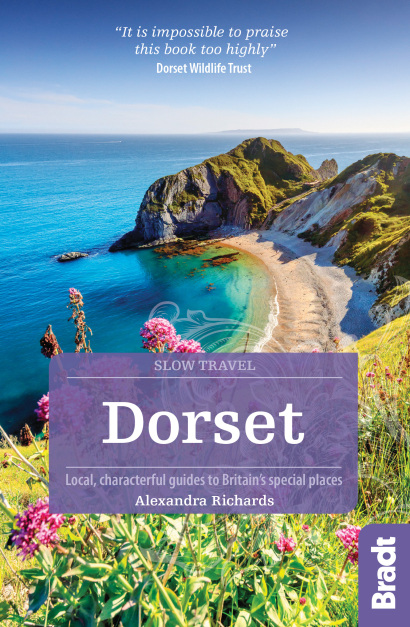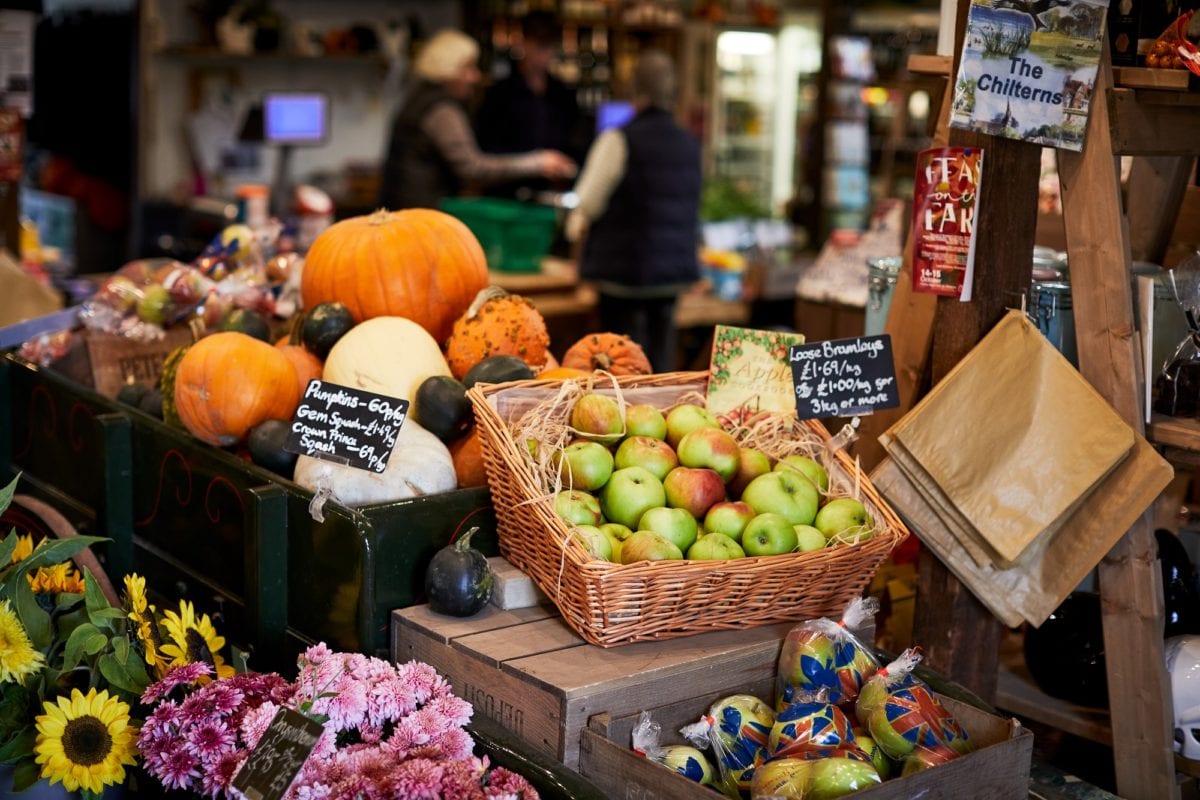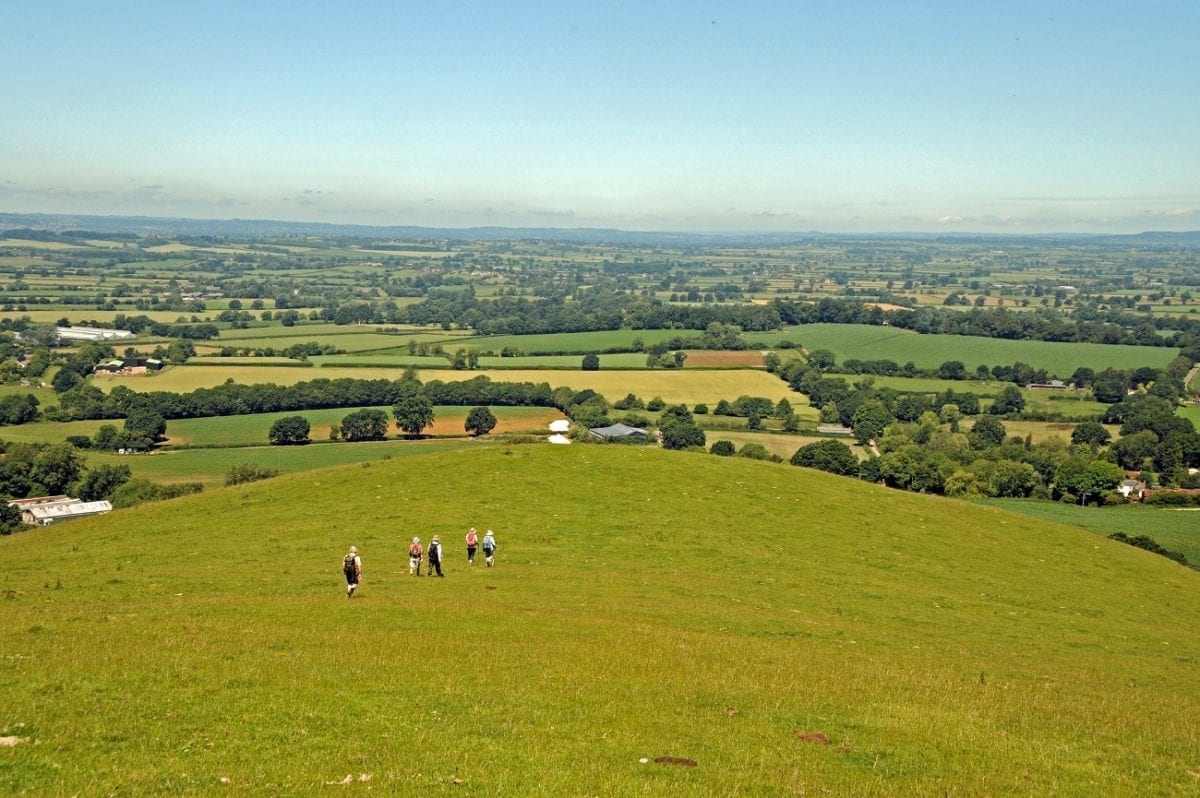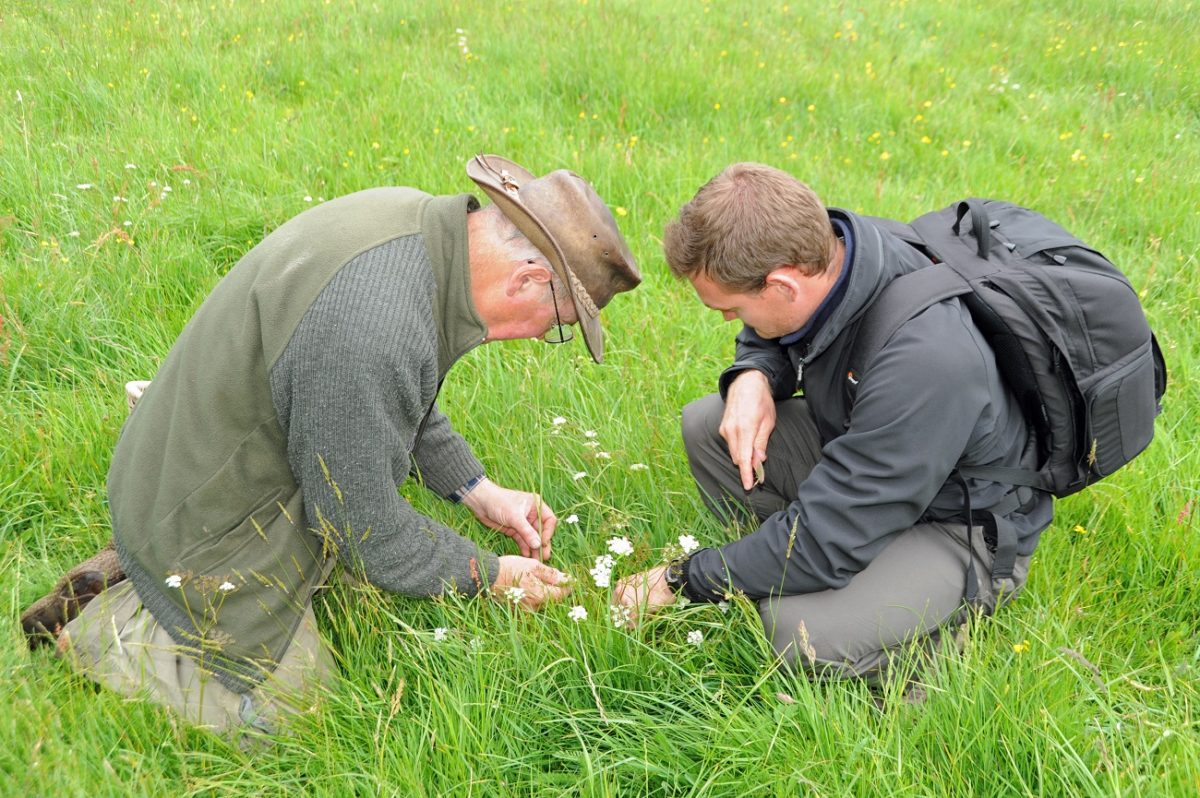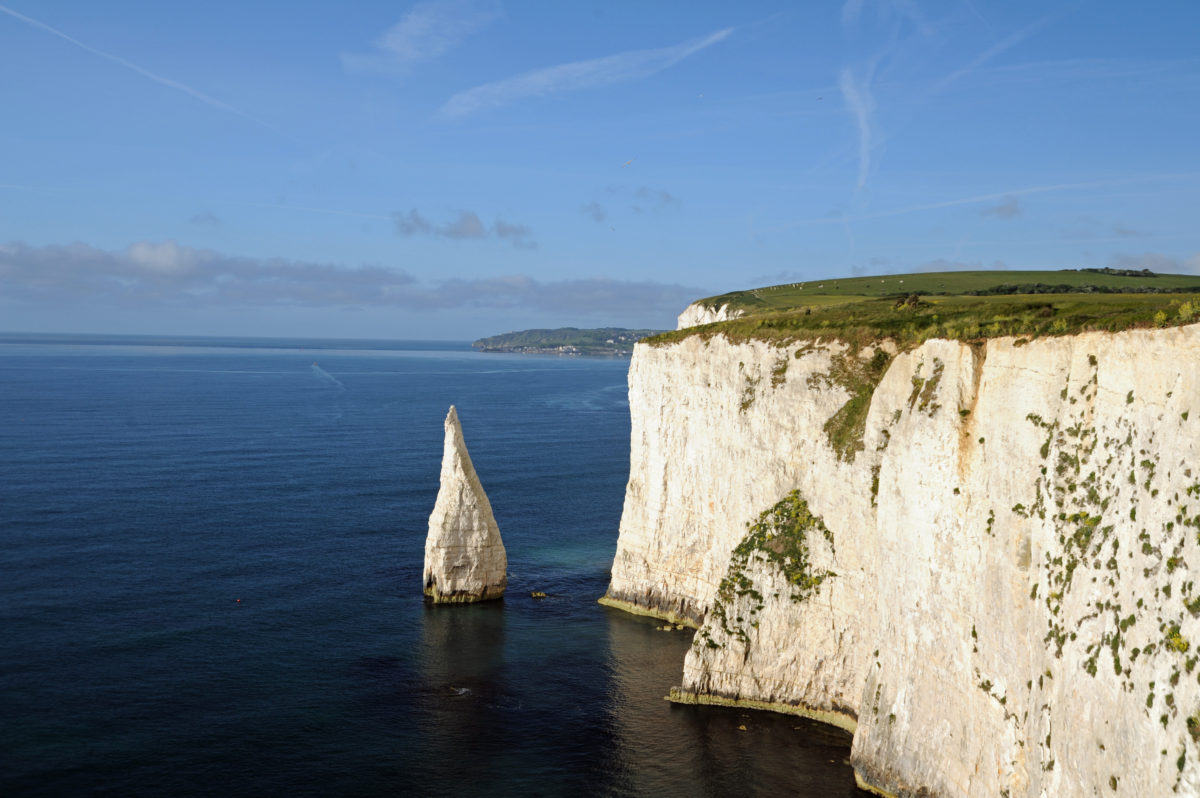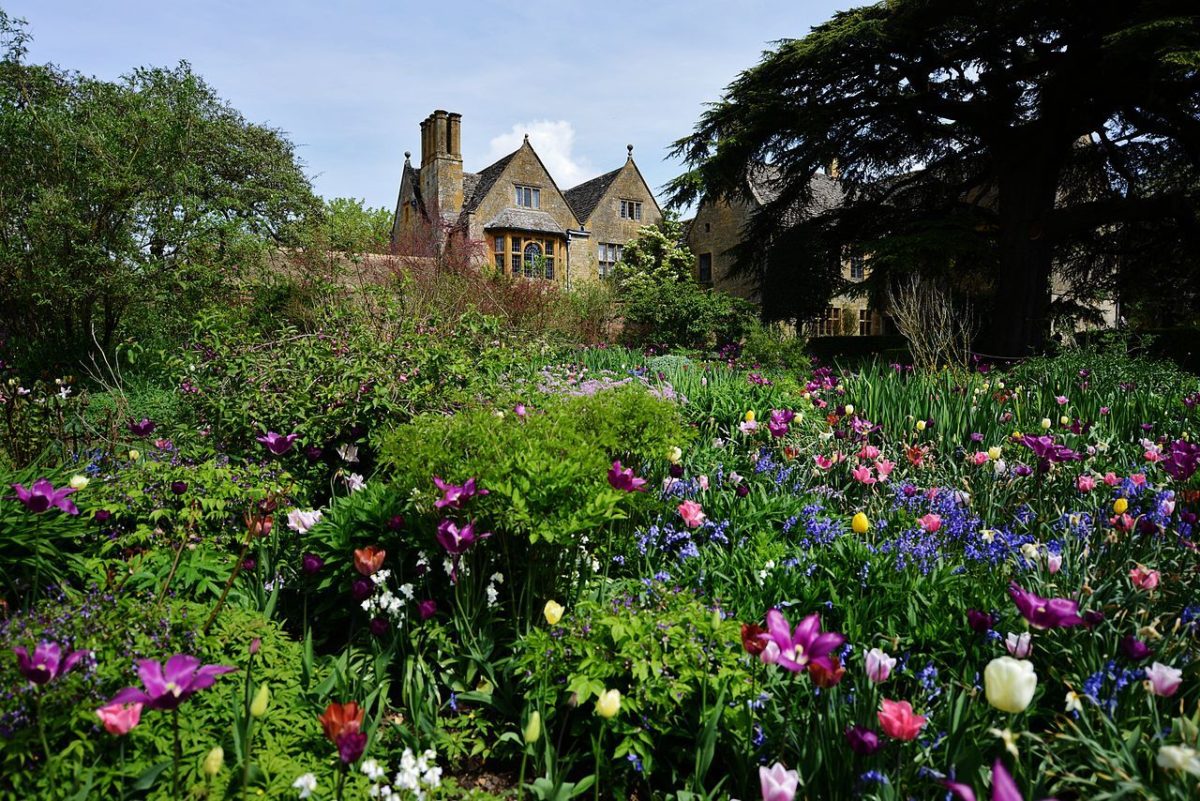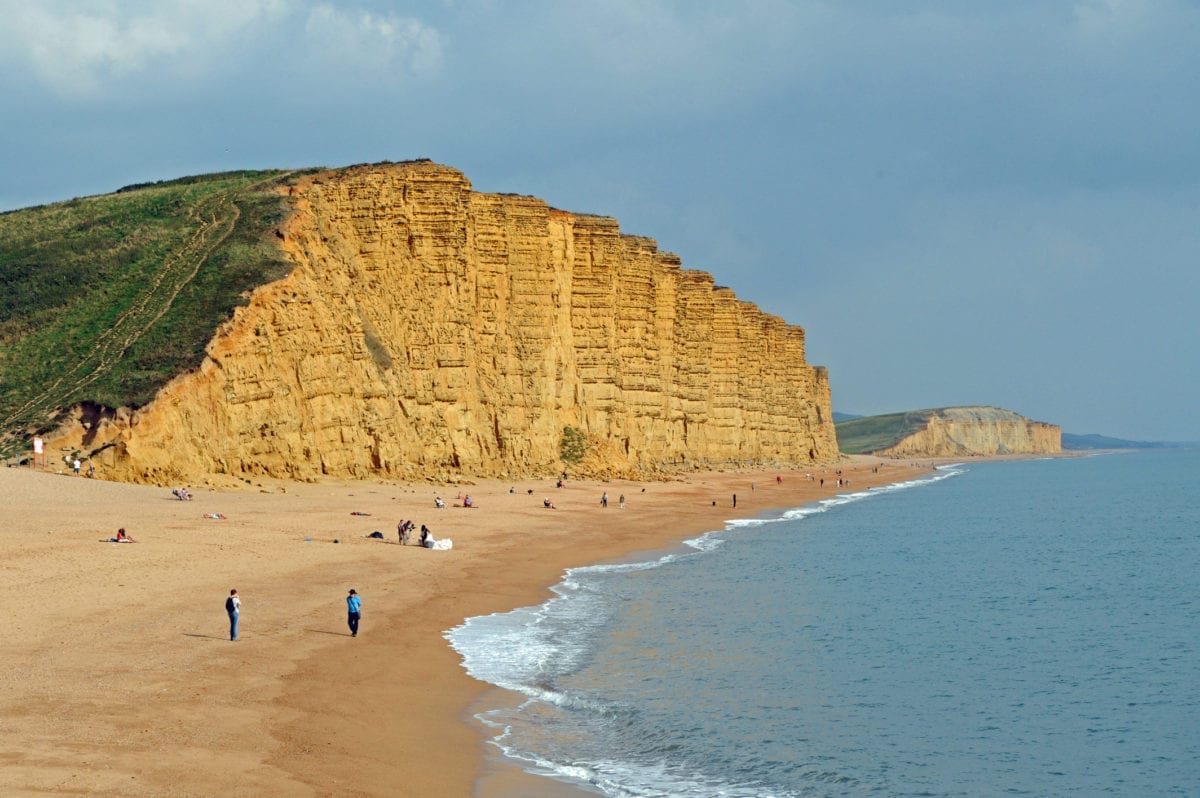One thing that strikes me about Dorset is how happy and proud people are to live here; they consider themselves lucky to dwell in this serene corner of England and are keen to preserve its landscapes and way of life.
Alexandra Richards, author of Dorset: the Bradt Travel Guide
Dorset lends itself to Slow travel – its quintessentially English rural landscapes, bountiful local produce… even the lilting Dorset accent has an unhurried, lullaby quality. It has no large cities and its only heavily populated area (Poole and Bournemouth) is discreetly tucked into the southeastern corner.
Yet Dorset’s variety means that it has a wide appeal – it has much to offer the lover of the natural world, the history buff, gastronome, archaeologist, hiker, adventure sports enthusiast and family on holiday, to name but a few.
As you wander around Dorset, ancient manmade additions to the landscape stand as reminders that you are walking in the footsteps of much earlier inhabitants. It seems just about every hill you climb has a Neolithic site lying beneath your feet and the countryside is dotted with the telltale lumps and bumps of ancient burial grounds.
The Iron Age hillforts of Hambledon Hill and Hod Hill provide memorable walks, almost aerial views of the Blackmore Vale and archaeological interest. Gentle, rolling chalk downland dominates the centre of the county, which is where the county town, Dorchester, is found.
The west is hillier, while the east features heathland and a coastline with fine sandy beaches. As you head west, the shore becomes gradually more dramatic and culminates in the ancient cliffs of the Jurassic Coast.
I must confess I was once one of the protective Dorset folk who referred to visitors as ‘grockles’, lamented the summer influx of ‘townies’ and bemoaned ramblers trampling over our land, but having returned home with fresh eyes, I am positively evangelical about sharing the county’s delights with those who want to experience it the Slow way.
Bradt on Britain – our Slow Travel approach
Bradt’s coverage of Britain’s regions makes ‘Slow Travel’ its focus. To us, Slow Travel means ditching the tourist ticklists – deciding not to try to see ‘too much’ – and instead taking time to get properly under the skin of a special region. You don’t have to travel at a snail’s pace: you just have to allow yourself to savour the moment, appreciate the local differences that create a sense of place, and celebrate its food, people and traditions.
Food and drink in Dorset
Dorset is ideally suited to the growing and savouring of seasonal, traditional and local food; its fertile soils, long farming history and food heritage combine to provide a rich variety of tasty treats, from fish caught off the Dorset coast, to artisan cheeses, breads and ciders.

Food
A visit to Dorset would not be complete without sampling Dorset Blue Vinny cheese, Dorset apple cake and Moores Dorset Knob biscuits. And remember, Devon does not have a monopoly on cream teas – the Dorset version is just as delicious. You will find many artisan food producers and suppliers plus numerous local food festivals.
Self-caterers are spoilt for choice when it comes to stocking up the pantry, and a picnic is a great way to enjoy the Dorset countryside. Rather than trudging around the supermarket, you can make gathering your ingredients into a treasure hunt by calling into local bakeries, farmers’ markets and farm shops.
As you are exploring the country lanes, look out for handwritten signs promising free-range eggs, homemade jams, honey, gooseberries and the like, which usually sit on a wonky table next to an honesty box. For dessert you can pick up one of the local farmhouse ice creams, such as those made by Barford Ice Cream and Purbeck Ice Cream.
Drinking Dorset
To wash down your Dorset meal, you could try a locally made cider, like Cider by Rosie. In early October, apple pressing days are held around the county, and many places invite you to bring your own apples for pressing.
My late friend, Alf Wallis, remembered the days when badger leg was eaten in Dorset pubs; happily these days when you hear someone ordering a half a Badger in the pub they are after a beer from the Hall & Woodhouse Brewery. Dorset is well stocked with breweries, such as the Piddle Brewery and Palmers.
The county produces its own wine, thanks in no small part to its temperate climate. Available at farm shops, delicatessens and independent supermarkets. Furleigh Estate near Bridport is a dairy farm that has been transformed into a winery producing white, red, rosé and sparkling wines. Cellar door sales are available and winery tours take place on Fridays and Saturdays, plus Wednesdays in summer.
Wines from the Sherborne Castle Vineyard are available at the castle shop and other local outlets. Melbury Vale Vineyard sells its wines and liqueurs in shops and restaurants in the Shaftesbury area, and also at their winery shop. With 30 acres of land and 38,000 vines, Langham Wine Estate is the largest vineyard in the southwest of England. Winery tours can be booked online, and a tasting room and café operate in August and September. Lyme Bay Winery produces delicious fruit wines and fruit liqueurs, as well as cider and mead.
As we all know, dairy farmers have had to diversify. A creative diversification is Black Cow vodka, a smooth vodka made from milk and with a distinctly creamy quality. It is available in delicatessens and farmshops around Dorset.
Where to stay in Dorset
For information about accommodation, see our list of the best places to stay in Dorset
What to see and do in Dorset
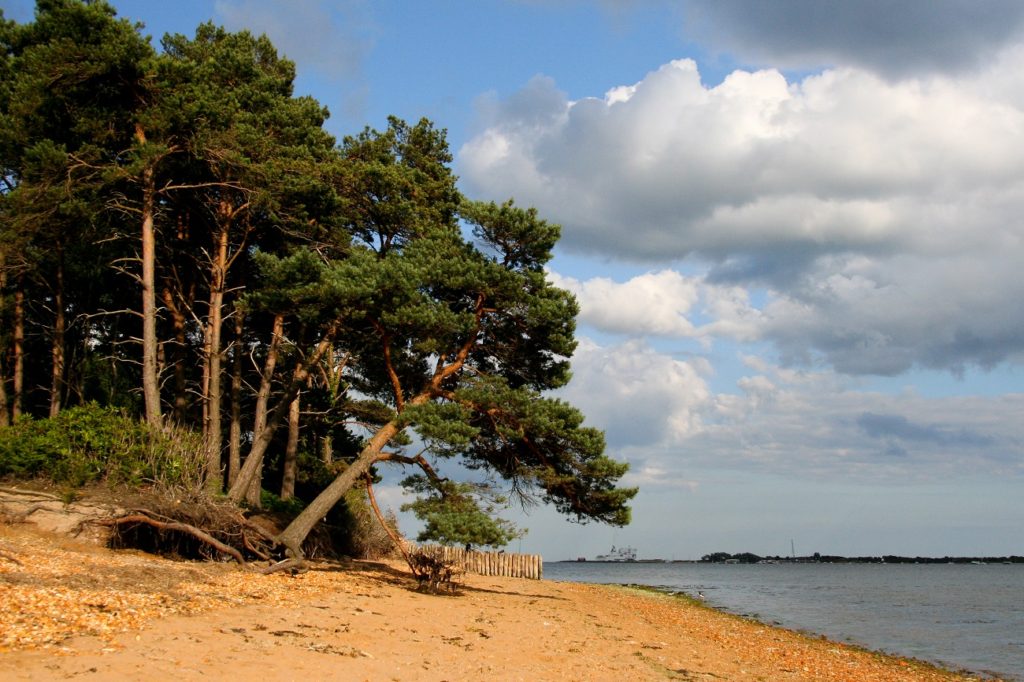
Brownsea Island
A car-free haven for wildlife as well as the starting point of the Boy Scout movement, Brownsea is the largest of the islands in Poole Harbour and one of Dorset’s treasures. The journey to the island gives the impression that you are travelling to a magical, faraway land; arriving by boat, the first thing you see is the island’s few stone houses and the castle, with a backdrop of woodland.
The whole island, with its combination of woodland, heathland, wetland, seashore and lagoon, is rich in wildlife. Over 100 native and introduced species of trees grow on Brownsea, providing a shady canopy for walks. Pheasants roam the woodland, the descendants of those introduced for shooting parties, while the pine forest is the domain of goldcrests, woodpeckers, nuthatches and treecreepers. The open heath supports diverse butterfly species, common lizards and nightjars.
The first castle on Brownsea was built in the time of Henry VIII as one of a string of defences; in the 18th century it was rebuilt as a residence. In the late 19th century it burnt down and was again rebuilt; today the John Lewis Partnership rents it as a hotel for its employees and it is not open to the public.
The visitor centre is a good starting point and provides information on the island’s history, flora and fauna. Exploring the island independently is straightforward and rewarding; you can download a walking trail from the National Trust website.
There really is great pleasure in walking around an island where there are no roads and no traffic, and absorbing sea views. Around the quay and visitor centre are traces of the communities that have lived here, including St Mary’s Church, built in 1853 by the island’s then owner, Colonel Waugh. The church has remained virtually unchanged since its construction and there is no electricity and no water supply, but its services are often well attended.
The island was the site of Major-General Robert Baden-Powell’s original experimental scout camp in 1907, which gave rise to the international scouting movement. A memorial commemorates the first camp and a permanent scout campsite now exists on the island.
Cerne Abbas
Travellers along the A352 are treated to a very unusal and surprising sight – the 180-foot-tall chalk carving of a naked man known as the Cerne Abbas Giant. He is also known as ‘The Rude Man’, for reasons (actually one very obvious reason) that become apparent when you look at him from the roadside viewpoint. There’s a good chance that the postcards of the Rude Man in his birthday suit are the county’s best-sellers.
There is far more to Cerne Abbas than the giant, though – it is a captivating village with a mixture of architectural styles evoking different eras, from medieval to Georgian. It grew up around a Benedictine abbey founded in AD987 but largely destroyed after the Dissolution of the Monasteries in the 16th century.
What little remains of the abbey is now part of a private house at the top of Abbey Street but can be visited for a small fee: the Abbot’s Porch, built as the entrance to the abbey in the early 1500s, and the abbey guesthouse, a rare surviving example of a monastic guesthouse.
As you walk up Abbey Street towards the abbey ruins, you will pass an attractive duck pond and just beyond it a gate leads into a burial ground believed to date from the time of the abbey. Looking a little out of place among the gravestones is the medieval Preaching Cross, a stone shaft set into a squat hexagonal base, which travelling priests would have used to give communion to local residents.
If you follow the wall on your right as you go into the burial ground you will come to St Augustine’s Well. Also known as the Silver Well, this is another of the few relics remaining from the days of the abbey. According to legend, St Augustine of Canterbury (died AD604) visited Dorset and met some shepherds in the then uninhabited Cerne Valley. He asked if they would prefer beer or water to quench their thirst. When they replied ‘water’, the saint struck the ground with his staff and the spring started to flow. Some cynical folk have suggested that the Benedictine monks of Cerne Abbey fabricated the story to attract pilgrims.
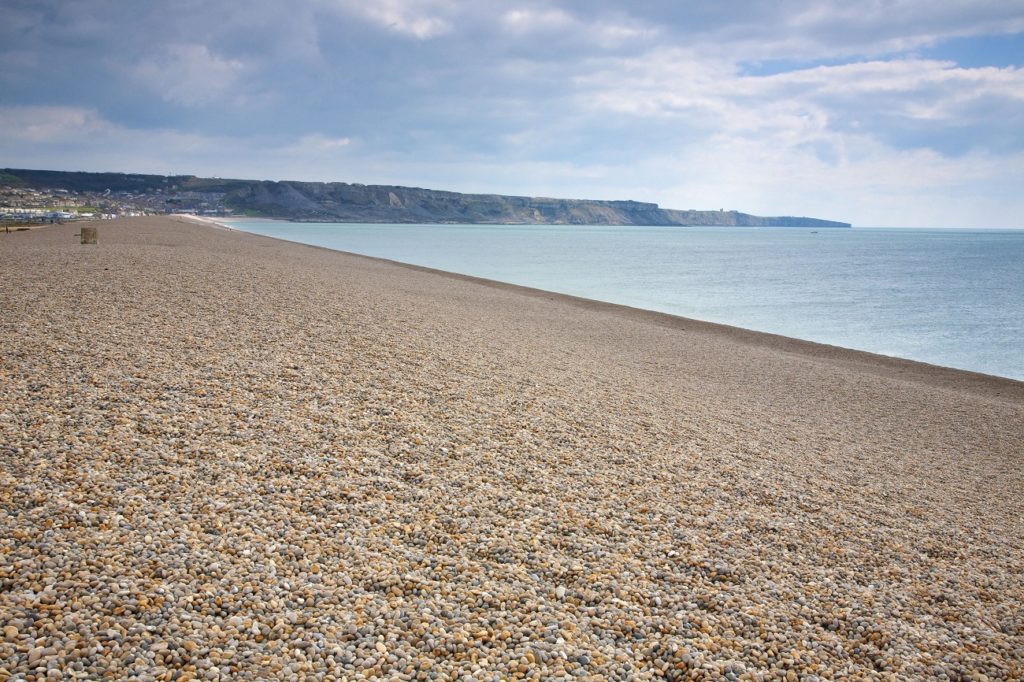
Chesil Beach
Stand on Portland Heights or outside St Catherine’s Chapel high above Abbotsbury and look out to sea and you will be treated to the most extraordinary sight – a wide, golden, shingle bank rising out of the water and running along the coastline, with a lagoon sheltering sheepishly behind it. If you saw such a thing in Dubai you might assume it was the zany creation of a capricious sheikh, but this is Dorset and Chesil Beach is all natural.
Stretching for 18 miles between West Bay and Portland, Chesil Beach is the largest of three major shingle structures in Britain. The shingle bank, which reaches around 40 feet at its highest point, was formed by rising seas at the end of the last Ice Age.
Its rounded pebbles have been graded in size by strong tidal currents; they are as small as peas at the western end and the size of oranges at the Portland end. For centuries the size of the pebbles has been helping locals, mostly smugglers and fishermen, pinpoint where they are landing on the beach.
The lagoon, known as The Fleet, extends from Abbotsbury to Portland and contains a mixture of salt- and freshwater. Home to an abundance of birdlife, wading birds can be seen all year, while brent geese from Siberia and red-breasted merganser (fish-eating duck) visit in winter. The birds’ ancestors must have had quite a shock back in 1942–43, when Barnes Wallis’s famous bouncing bomb was tested on The Fleet in preparation for the Dambusters raids.
At the southern end of The Fleet, just before you head over the causeway from Weymouth to Portland, is the Fine Foundation Chesil Beach Centre and a pay-and-display car park with direct access to Chesil Beach. The centre is run by Dorset Wildlife Trust and provides information on Chesil Beach, the Fleet and Portland.
Binoculars allow you to watch seabirds feeding on the sand flats and there is live video from cameras on the bed of the lagoon. It is worth checking whether any sections of the beach are closed, as during nesting season (usually April to August) parts are off limits to avoid disturbing the birds.
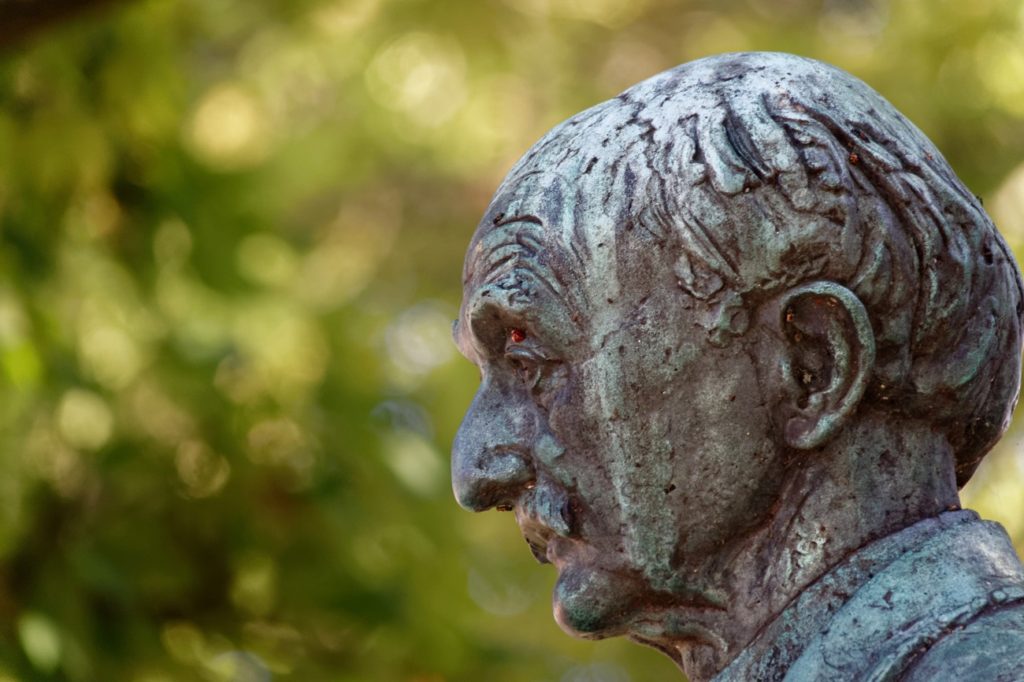
Dorchester
Dorchester as you see it today has been forged over a long and fascinating history. One of the great pleasures of wandering around the town is the chance to trace portions of that history by visiting sites of Neolithic, Roman, medieval and more recent importance.
The Dorchester area has been inhabited since Neolithic times, c4000BC, with settlements based around what later became the Iron Age hillfort of Maiden Castle to the southwest of the town. When the Romans arrived in AD70 they laid out what is now the town of Dorchester, which they called Durnovaria, in their usual cruciform manner, surrounded by a wall.
The basic structure of the town remains unchanged. Today, pleasant avenues lined with lime, chestnut and sycamore trees trace the town walls. Known as The Walks, the avenues were laid down in the 18th century and to wander along them is an enjoyable way to get a feel for the town. As you explore, it may strike you that Dorchester does not look as old as you may expect. That is because much of medieval Dorchester was lost in five devastating fires between 1613 and 1775 – though thankfully the rebuilding left streets of handsome 18th-century houses.
Dorchester has a surprisingly long and varied list of museums, some devoted to themes that have little to do with the area, such as the Tutankhamun Exhibition on West Street, a recreation of the treasures, and the Terracotta Warriors Museum on High East Street. Of the town’s museums, two really stand out as worth visiting: the Dorset County Museum and the Keep Military Museum of Devon and Dorset.
The clues pointing to Dorchester’s Roman origins were certainly not lost on Thomas Hardy. In his novel The Mayor of Casterbridge, Hardy based the fictional town on Dorchester, which he knew well, being born and raised in the area. His description of Casterbridge may as easily have been a description of Dorchester: ‘Casterbridge announced old Rome in every street, alley and precinct. It looked Roman, bespoke the art of Rome, concealed the dead men of Rome.’
Dorchester’s Roman origins are even more evident today than they were in Hardy’s time, for Hardy would not have seen the most striking proof of Roman occupation, the Roman Town House. The house, which dates from the 4th century, was found in 1937 during the building of a new county hall and is the only fully exposed Roman townhouse in the country.
Dorchester’s High Street is inviting, brimming with character, points of interest and some decent shops. On the south side of High West Street are the only timber-framed buildings surviving in anything like their original state.
The black-and-white building at 6 High West Street is where Judge Jeffreys (‘The Hanging Judge’) lodged during the trials of those who took part in the Monmouth Rebellion of 1685. The trials, known as the Bloody Assizes, were held in the Oak Room (now a tea room) of the Antelope Hotel. Judge Jeffreys, whose deadly zero-tolerance policy made him highly unpopular, is said to have had a secret passage leading there from his lodgings.
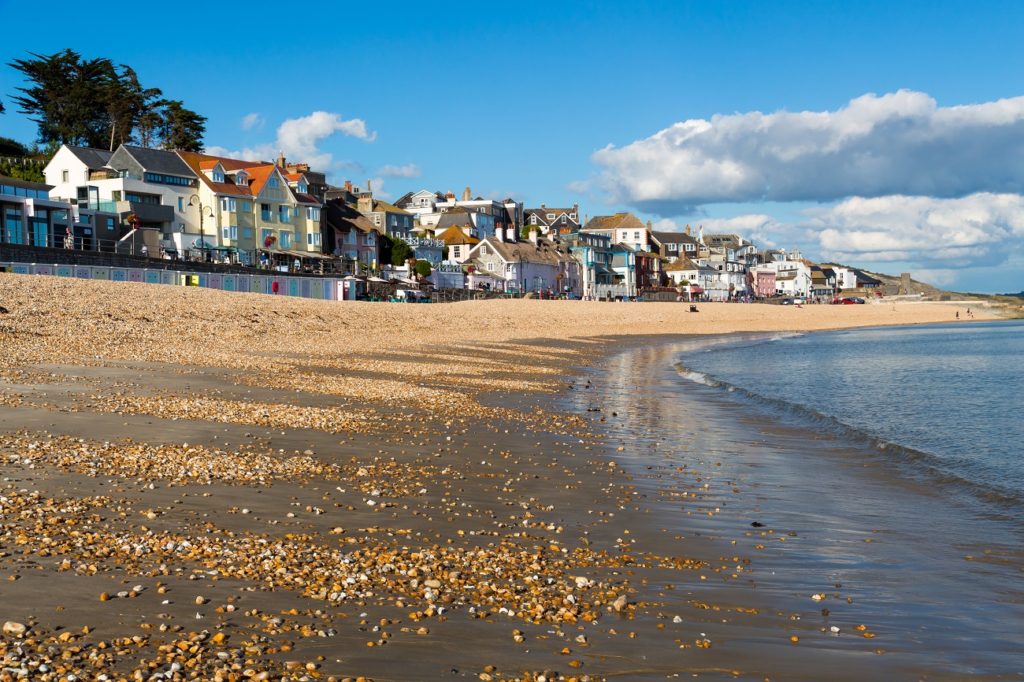
Lyme Regis
Somehow Lyme Regis doesn’t look real: with its rows of houses of every shape and size huddled together along the seafront beneath open fields and woodland, it looks more like a painting in a children’s book, or perhaps a model town. You might half expect to see an oversized adult bending down peering through the windows of the cottages.
Lyme Regis snuggles up against the Dorset/Devon border, on the River Lim. The Jurassic blue-grey cliffs on either side of the town are filled with layers of fossils, making the beaches of Lyme Regis excellent for fossil hunting. The narrow, twisting (and in parts steep) streets lead down through the town to the attractive seafront and the manmade harbour protected by the ancient breakwater known as The Cobb.
The town is best explored on foot as the centre is compact, packed with small shops, eateries and art galleries, and there is little room for cars. At the northern end of the seafront you will find the tourist information centre, which, as well as the usual brochures on accommodation, places to eat and activities can provide tide times – essential if you plan to go fossil hunting.
The Cobb
Lyme Regis is perhaps at its most enchanting viewed from The Cobb at sunset, when the sun illuminates the hills above the harbour and you can see the geological layers within the cliffs, stacked like a deck of cards. Sheltering behind the breakwater is a colourful array of fishing and pleasure boats.
The Cobb has been protecting the harbour and the town from erosion since the 13th century. It was originally made from huge boulders inside oak walls and detached from the land at high tide. It was joined to the land in 1756 and rebuilt in Portland stone in the 1820s, as the gently tilting serpentine wall that you see today.
Fossil hunting
Made from soft clay layered with a few hard bands of limestone that formed on the bottom of the sea during the early Jurassic period, some 190 million years ago, the grey cliffs of the Lyme Regis area regularly offer up some valuable clues about life on earth in geological ages past.
The Jurassic fossils within the cliffs are derived from sea creatures that lived when dinosaurs roamed the land. Landslides and waves cause fossils to fall from the cliffs on to the beaches below, making them prime fossil-hunting territory.
Sherborne
This ancient town marking the boundary of the Blackmore Vale has much to offer the visitor, including two castles, a splendid abbey and a charming town centre. Allow at least one full day to explore. Sherborne has an impressive aristocratic pedigree spanning hundreds of years and exudes a refined sense of style.
In most towns and villages in the Blackmore Vale you will see a farmer fresh from his tractor (which may be parked around the corner) or a woman in well-worn jodhpurs and wellies popping into the bank or the grocer, but this doesn’t seem to happen here. I get the impression that Sherborne would frown upon such activity because it is the sort of place where you get dressed up and slap on some make-up to go shopping.
Sherborne’s aristocratic pedigree is embodied in its finest buildings, Sherborne Abbey, Sherborne Old Castle and Sherborne Castle (built by Sir Walter Raleigh), which are all open to the public.
A stroll around the town centre with its medieval buildings is enough to gain an appreciation for the town’s history; it dates back to the Saxons, who named the town ‘scir burne’, meaning the place of the clear stream, and made it the capital of Wessex. Today it is a vibrant market town and a centre of learning, thanks to its three private schools: Sherborne Boys, Sherborne Girls and Leweston.
Sherborne Abbey
The centrepiece of Sherborne is undoubtedly its abbey, a glorious spectacle of architecture and history. Resplendent in its golden hamstone, it stands proudly on a perfectly groomed lawn platform, surveying the goings-on of the town. In front a memorial commemorates George Winfield Digby of Sherborne Castle, one of the principal financiers of the abbey’s Victorian restoration.
Perhaps the abbey’s most striking architectural feature is its superb fan-vaulted stone roof, the earliest in England. In his book, England’s Thousand Best Churches, Simon Jenkins proclaims, ‘I would pit Sherborne’s roof against any contemporary work of the Italian Renaissance.’ Another highlight is the engraved glass reredos (1968) by Lawrence Whistler in the Lady Chapel.
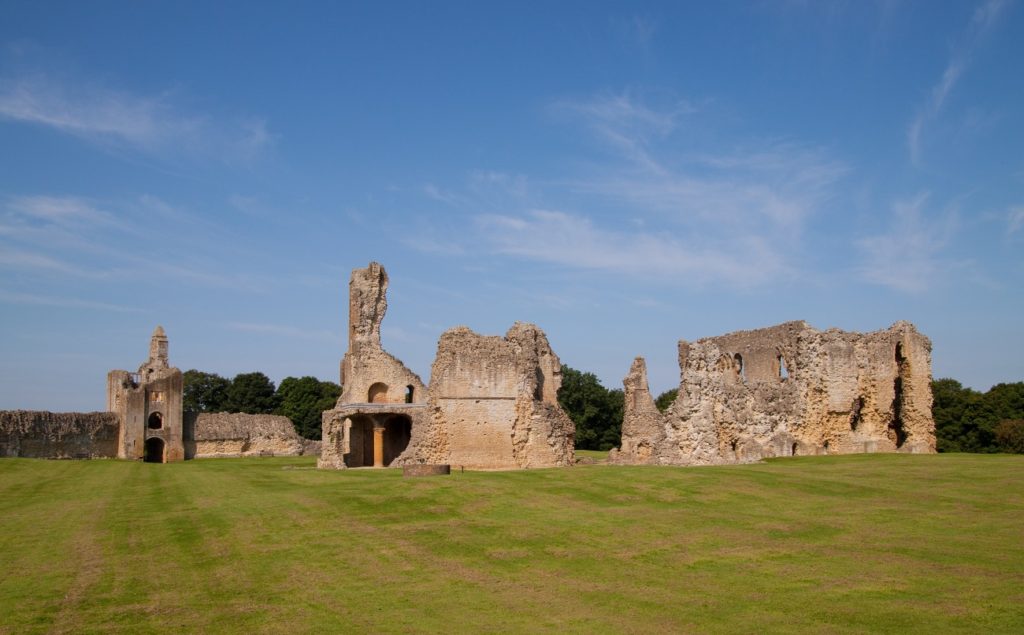
Sherborne Old Castle
This atmospheric ruin lies to the east of the town, in the grounds of the new Sherborne Castle, and is all that remains of the original, which was destroyed by Cromwell’s troops during the Civil War. It reportedly took 16 days for Cromwell’s men to bring the castle down in 1645; only the imposing gatehouse, parts of the keep and the outer walls survive, surrounded by a moat.
The entrance passes over a modern bridge with the piers of the medieval one beneath it. It is a serene spot with fine beech trees, views of the surrounding countryside and the town. It oozes history and mystery, conjuring up images of medieval banquets and battles.
Sherborne Castle
Having decided that Sherborne Old Castle was not fit for habitation, Sir Walter Raleigh built this Elizabethan mansion on the other side of the River Yeo in 1594. Raleigh and his wife enjoyed their new home for less than nine years before his execution during the reign of James I.
In 1617 the estate, with its two castles, was purchased by Sir John Digby and has remained in the family ever since. At its core is the house built by Raleigh with polygonal turrets in each corner. It was extended in a similar style (more turrets) by various Digbys through the generations, giving it its rather unusual shape. During World War I the house was used by the Red Cross as a hospital, and in World War II as the headquarters for the commandos involved in the D-Day landings.
Related books
For more information, see our guide to Dorset:
Related articles
Ideal for picking up some produce for a picnic or a family day out.
Savour the tastes of Dorset with this recipe for the county’s world-famous apple cake.
This unspoilt region is dotted with charming, quintessentially English villages, many of which are built from warm, golden stone.
Some helpful tips for foraging in the wild in Dorset from expert John Wright.
From fossil hunting to fantastic walking trails, the Dorset coast has something for everyone.
These are some of our favourite green spaces to wander in England.
Dorset’s diverse countryside and coastline provide excellent activities and opportunities for exploration on foot, horseback or bike.
